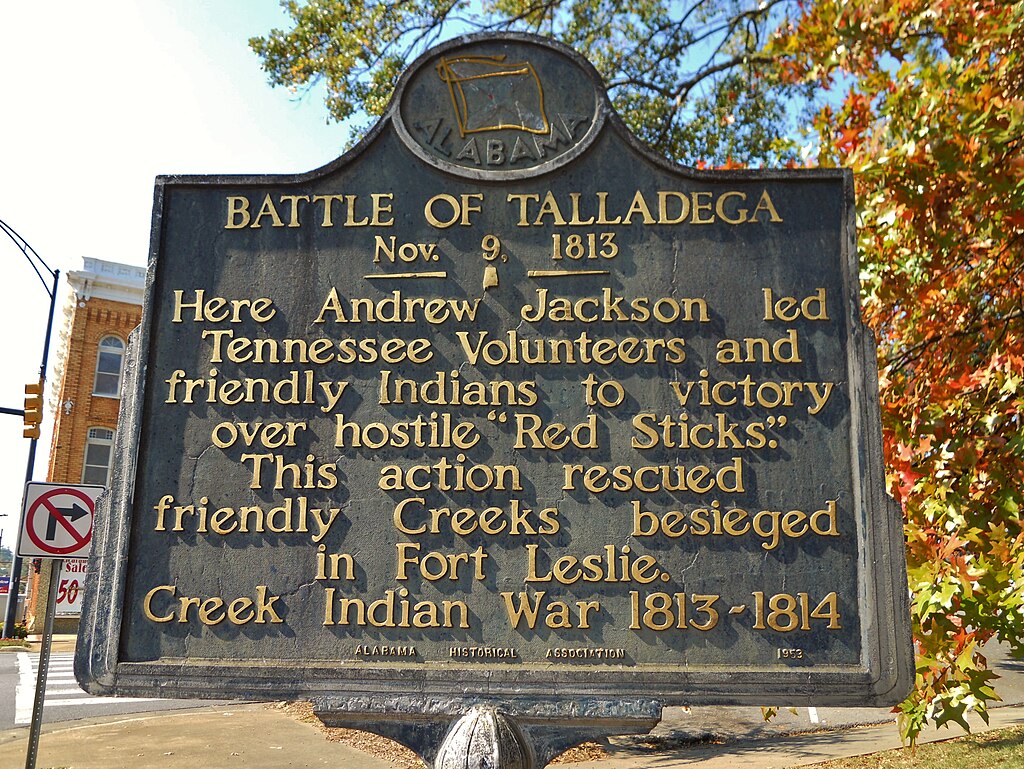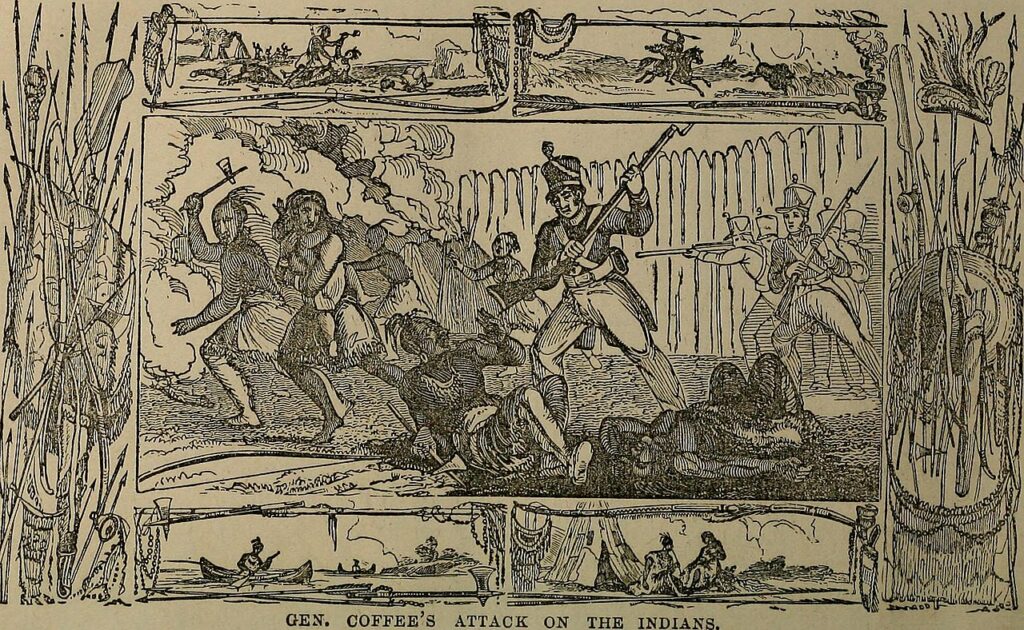Fort Leslie, a pivotal site in Talladega County, Alabama, played a crucial role during the Creek War and the War of 1812. Built by Alexander Leslie, it protected settlers against the Red Stick Creek Indians.
General Andrew Jackson, with his Tennessee militia and cavalry led by General John Coffee, utilized Fort Leslie for strategic operations, including the significant Battle of Tallushatchee.
The fort’s proximity to the Coosa River provided vital logistical support.
The fierce resistance at Fort Leslie, alongside battles at Fort Mims and Fort Morgan, marked a decisive chapter in American history, impacting family members and soldiers alike.
History of Fort Leslie (Alabama)

Fort Leslie, located in what is now Talladega County, Alabama, played a significant role during the Creek War and the War of 1812.
Built by Alexander Leslie, the fort provided a protective stockade for settlers against the Red Stick Creek Indians.
General Andrew Jackson extensively utilized Fort Leslie. His Tennessee militia, alongside cavalry led by General John Coffee, staged operations from here.
Notably, they launched assaults on Creek strongholds, including the Battle of Tallushatchee on November 3, 1813.
The Siege of Fort Leslie highlighted its strategic importance. Creeks attacked the fort but were met with fierce resistance by American settlers and soldiers.
This period saw frequent skirmishes and heightened tensions between the settlers and Creeks.
The fort’s location near the Coosa River allowed logistical support and troop movements. This was crucial in battles such as Horseshoe Bend, where Jackson’s forces decisively defeated the Creek Nation.
The victory at Horseshoe Bend significantly weakened the Red Sticks and led to their eventual surrender.
Among those who served at Fort Leslie was the renowned frontiersman Davy Crockett. His presence added a layer of prominence to the site.
Fort Leslie also connected with other forts, such as Fort Strother, Fort Talladega, and Fort Williams, creating a network of defenses against the Creek threat.
Chief Selocta and his warriors often interacted with forces at Fort Leslie during campaigns against the Red Stick Creeks.
Additionally, the fort connected historical figures and places, influencing regional history and contributing to American expansion.
Geographic Significance
Fort Leslie is located in Talladega, Alabama. Its location on the banks of the Coosa River is crucial to its strategic importance.
The river provided a natural defense and a means for transport and trade.
The fort is also near Big Springs, a freshwater source vital to the garrison’s daily needs.
The presence of abundant water resources made the area suitable for long-term settlement.
Additionally, Talladega’s location within Alabama placed Fort Leslie in a region with rich natural resources. This contributed to its economic and logistical significance.
The combination of the river for transport, the springs for water supply, and the locale rich in resources made Fort Leslie a key asset. These features underpinned both its military and economic roles.
Military Engagements

Fort Leslie in Alabama played a significant role in multiple military engagements during the Creek War, including the Battles of Talladega, Horseshoe Bend, and Tallushatchee.
Battle of Talladega
The Battle of Talladega was fought on November 9, 1813. General Andrew Jackson led an American force, including the Tennessee militia, against the Creek Indians.
Fort Leslie served as a defensive position for the Americans during this engagement. The battle was marked by intense fighting, with the American forces eventually overpowering the Creeks.
Casualties were significant on both sides, but the victory was a strategic win for Jackson and his forces. The engagement helped diminish the Creek’s influence in the region and demonstrated the tactical effectiveness of the militia and their command.
Battle of Horseshoe Bend
Fought on March 27, 1814, the Battle of Horseshoe Bend was a decisive conflict in the Creek War. General Andrew Jackson, with a force of militia, regular infantry, and allied Native Americans, encircled the main Creek encampment on a peninsula formed by the Horseshoe Bend of the Tallapoosa River.
Using a combination of artillery and direct assaults, Jackson’s forces broke the Creek defenses, leading to heavy casualties. Over 800 Creek warriors were killed, and the battle effectively ended the Creek resistance.
As a result, the Creek Nation ceded vast lands to the United States, reshaping the regional geopolitical landscape.
Battle of Tallushatchee
The Battle of Tallushatchee occurred on November 3, 1813. It was one of the early engagements of the Creek War and was led by General John Coffee, a close ally of Andrew Jackson.
Coffee’s cavalry and infantry surrounded the Creek village of Tallushatchee. The engagement began with an assault on the palisaded village, which led to fierce combat.
The American forces were victorious, resulting in substantial Creek casualties, including many women and children. The brutal battle underscored the ferocity of the conflict between the American forces and the Creek Indians.
These engagements were crucial in the American campaign to secure the Southeastern frontier and weaken the Creek Nation’s power.
Each battle demonstrated the strategic importance of military leadership, tactics, and the support drawn from local militias.
Explore More: Army Forts in Alabama
Cultural and Political Impact
Fort Leslie, located in Alabama, played a key role in the cultural and political landscape.
This fort was central during the War of 1812, serving as a stockade fort for protection. It was primarily used to defend settlers against attacks by the Creek Nation, particularly during the Red Sticks uprising.
The presence of French and British influences in the region added to the complexities faced by the settlers.
| Entity | Relevance |
|---|---|
| Red Sticks | Faction of the Creek Nation |
| Creek Nation | Native American tribe involved in conflicts |
| War of 1812 | Conflict during which the fort was active |
| Stockade Forts | Type of protective structure |
| French and British | European influences in the region |
Many of the protective stockades built during this period aimed to safeguard against the Creek Nation, which was allied with British forces.
Fort Leslie’s impact is evident in the settlements that emerged around it. These settlements often became the foundation for future towns and cities in Alabama.
Politically, Fort Leslie’s existence bolstered American efforts to maintain control over the contested territories during wartime.
The fort’s strategic importance also influenced treaty negotiations with Native American tribes, shifting power dynamics in the region.
Explore More: 19 Historic Forts in Alabama
Modern Developments
Fort Leslie, situated in Talladega County, has seen numerous modern developments enhancing its historical significance.
Fort Lashley Avenue has become a central route, linking key areas in Talladega.
Efforts to preserve Fort Leslie have aligned with conservancy initiatives. Its inclusion in the National Register of Historic Places has ensured protection and funding for restoration projects.
Local engagements with indigenous history, especially the Natchez tribe and Chinnabee’s town, have grown. These efforts provide educational resources and promote cultural awareness.
Talladega has welcomed various infrastructural improvements. The increased foot traffic and interest in Fort Leslie have benefited local businesses and tourism.
Key Modern Developments
- Fort Lashley Avenue:
- Central route improving connectivity
- Boosts local commerce and tourism
- Conservancy Efforts:
- Inclusion in the National Register of Historic Places
- Supported restoration and preservation projects
- Cultural Awareness:
- Engaging with Natchez tribe history
- Promoting educational initiatives about Chinnabee’s town
Impact on Talladega and Talladega County
- Enhanced local infrastructure
- Growth in local economy via tourism
- Increased cultural and historical education

Cory is a website owner and content creator who enjoys fishing, history, coin collecting, and sports, among other hobbies. He is a husband and father of four.
Romans 15:4 For whatever was written in former days was written for our instruction, that through endurance and through the encouragement of the Scriptures we might have hope.

